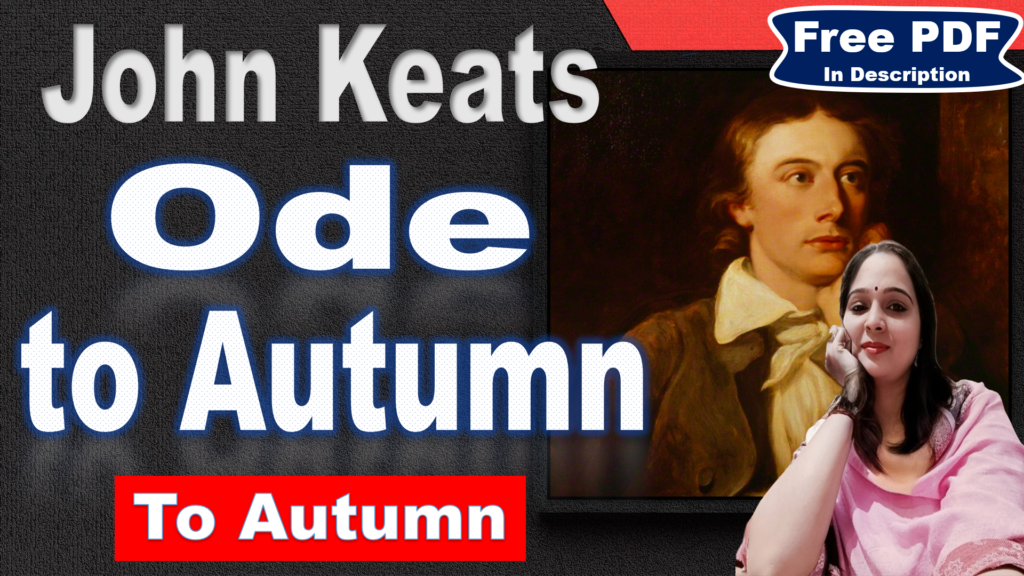
Ode to Autumn Summary
This beautiful poem is titled “To Autumn” and was written by the English Romantic poet John Keats. It was composed in September 1819 and is considered one of Keats’s finest works. The poem vividly captures the sights, sounds, and sensations of autumn, celebrating the richness and abundance of the season.
The first stanza sets the tone by describing autumn as the “season of mists and mellow fruitfulness.” Keats personifies autumn as a close friend of the sun, conspiring with it to bring about the ripening of fruits and the swelling of gourds. The imagery includes moss’d cottage-trees, apples, hazel shells, and buzzing bees, creating a lush and sensory depiction of nature’s bounty.
The second stanza shifts to a more personal interaction with Autumn, asking where it can be found amid its store. Keats describes Autumn sitting on a granary floor, with hair lifted by the wind, or peacefully asleep in a half-reap’d furrow. The poet portrays Autumn as a laborer, steady and patient, overseeing the extraction of cider from a press.
The third stanza reflects on the absence of the songs of spring, urging the reader not to dwell on them. Instead, the focus is on the music of autumn, with imagery of barred clouds, stubble-plains, gnats, river sallows, lambs, hedge-crickets, red-breasts, and swallows. The poem ends with a celebration of the unique and melodious sounds that characterize autumn.
“To Autumn” is renowned for its rich imagery, vivid descriptions, and the seamless blend of sensory experiences, making it a timeless ode to the beauty of the changing seasons.
Key Points
Author
John Keats (31 October 1795 – 23 February 1821) was an English Romantic poet. He was one of the main figures of the second generation of Romantic poets, along with Lord Byron and Percy Bysshe Shelley.
Form
“Ode to Autumn” is an ode, a lyrical stanza in praise of or dedicated to someone or something, which captures the poet’s thoughts and feelings. The poem consists of three stanzas, each containing eleven lines. The poem is written in iambic pentameter. The first stanza has a rhyme scheme of ABABCDEDCCE while stanzas 2 and 3 have a rhyme scheme of ABABCDECDDE.
Speaker
The speaker in the poem can be considered a lyrical persona of the author himself, John Keats. Unlike the speakers in Keats’ other odes, who are more concerned with themselves, the speaker in “To Autumn” is solely concerned with the season.
Setting
The setting of the poem is during autumn, a season of mists and mellow fruitfulness. The poem was inspired by a walk near Winchester along the River Itchen.
Theme
The central theme of “To Autumn” revolves around embracing the beauty and transience of life, appreciating nature’s abundance, and recognizing the cycle of existence. The poem expresses reverence and awe for the great changes wrought by nature as autumn brings its riches to the landscape.
Plot
The poem is a tribute to autumn by John Keats. It discusses the richness of autumn when the leaves fall, vegetables and fruits get ripened. The poem praises autumn, describing its abundance, harvest, and transition into winter.
Tone
The tone of “Ode to Autumn” is lively, revealing the richness of autumn. The poem’s tone is not completely elegiac, despite its keen understanding of the passage of time.
Style
The style of “Ode to Autumn” is characterized by Keats’s simple, sensuous, and direct love of nature. The poem uses intense, sensuous imagery to elevate the fleeting beauty of the moment.
Message
The central message of “To Autumn” revolves around embracing the beauty and transience of life, appreciating nature’s abundance, and recognizing the cycle of existence. It suggests that autumn is a reminder of the cycle of life and death.






I want pdf of this lecture